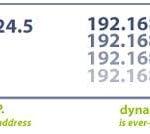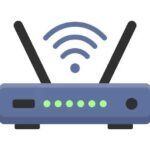How to change the Wi-Fi password on mobile phone
How to change Wi-Fi password on your mobile devices is easier on some Android phones than others due to different security policies and Wi-Fi password requirements. When you revisit any of your favorite places with a wireless network, and their Wi-Fi password is no longer the same, then ask them for the new Wi-Fi password and follow this procedure to learn how to change my wi-fi password on your mobile device.
Change my Wi-Fi password on an existing connection
- Swipe down on the home screen of your Android tablet or phone which should open the quick access menu.
- Long touch (touch and hold) on the Wi-Fi icon, this will open a list of possible wireless networks with Wi-Fi connections.
- If the Wi-Fi is turned off, toggle the slider switch to the right to turn on Wi-Fi.
- Tap on the Wi-Fi connection you want to change.
- If you have not set an static IP address, you should always use the default IP address.
- Change the password to the new password. If the password cannot be changed, look for an option to Forget Password and touch it. Then make a new connection to that Wi-Fi network.
If your phone doesn’t have a quick access menu, or you don’t see an Wi-Fi icon, you can use the Settings menu. To change your Wi-Fi password on Android, follow these steps:
- Open the Settings app.
- Touch Network & internet.
- Touch Wi-Fi.
- Touch and hold the Wi-Fi network whose password you want to change.
- Touch Manage network.
- Touch Advanced options.
- Touch Security.
- Enter the current password for the Wi-Fi network in the Password field.
- Enter your new password for the Wi-Fi network in the New password field.
- Enter your new password again in the Confirm password field.
- Touch Save.
Video – How to change my Wi-Fi password on an existing network?
Change my Wi-Fi password in your mobile device to connect to a secured website:

- On your Android device, open the Chrome app.
- Tap the 3 dots or More on the right side of the bar.
- Tap Settings > Passwords.
- Scroll down looking for the Wi-Fi connection you want to change the password for, and Touch it to open
- You can change the password on this page
- Tap Done when finished.
Here are some additional tips to change my Wi-Fi password:
- Make sure to choose a strong password. A strong password is at least 12 characters long and includes a mix of upper and lowercase letters, numbers, and symbols.
- Change your Wi-Fi password regularly. It is a good practice to change your Wi-Fi password every 6-12 months.
- Do not share your Wi-Fi password with anyone you do not trust.
How to export your passwords for all your various connections
To export your passwords for all your various connections, you can use a password manager app. There are many different password manager apps available, both free and paid. Some popular password manager apps include:
LastPass
1Password
Dashlane
Keeper
Bitwarden
Once you have installed a password manager app, follow the app’s instructions to export your passwords. Once you have exported your passwords, you can save them to a file or print them out.
Here are some additional tips for exporting your passwords:
- Make sure to save your exported passwords to a secure location.
- Do not share your exported passwords with anyone.
- If you are using a cloud-based password manager, make sure to enable two-factor authentication.
Additional tips to change my Wi-Fi password on mobile:
- Choose a strong Wi-Fi password. A strong password is at least 12 characters long and includes a mix of upper and lowercase letters, numbers, and symbols.
- Change your Wi-Fi password regularly. It is a good practice to change your Wi-Fi password every few months.
- Enable WPA2 security on your router. WPA2 is the most secure type of Wi-Fi security.
- Keep your router’s firmware up to date. Router manufacturers regularly release firmware updates that improve security and performance.
Change the password on your Wi-Fi router – Home or Office network
Changing your Wi-Fi password is a good way to improve the security of your home or office network. It is especially important to change your password if you think someone else may have access to it.
To change your Wi-Fi password, you will need to access the router’s configuration page. The steps for doing this vary depending on the make and model of your router. However, most routers can be accessed by typing the router’s IP address into a web browser. The most common IP address is http://192.168.1.1/ or a variation of it.
Log into the router – the default user name is usually “Admin” and the default password is “admin” or “password”. This works only if someone has not changed the default user name and password. If they have been changed, then you need to discover the actual user name and password.
Once you have accessed the router’s configuration page, you will need to find the Wi-Fi settings. These settings are usually located under a heading such as “Wireless Security” or “Wi-Fi Security.”
In the Wi-Fi settings, you will find the field for your Wi-Fi password. Enter your new password into this field and click the Save button.
Once you have saved your new password, your router will restart. This may take a few minutes. Once the router has restarted, your Wi-Fi network will be secured with your new password.
If you have any trouble changing your Wi-Fi password, you can consult the router’s documentation or contact the manufacturer of your router for assistance.
Frequently asked questions (FAQ) and answers about how to change my Wi-Fi password on mobile:
Q: Why should I change my Wi-Fi password?
A: You should change your Wi-Fi password regularly to help protect your network from unauthorized access. If someone has your Wi-Fi password, they can access your internet connection and even steal your personal data.
Q: How often should I change my Wi-Fi password?
A: It is recommended to change your Wi-Fi password every 3-6 months, or more often if you suspect that someone may have your password.
Q: How do I change my Wi-Fi password?
A: The steps for changing your Wi-Fi password will vary depending on your router model. However, most routers can be configured to change the Wi-Fi password through the router’s web interface. To access the router’s web interface, you will need to know the router’s IP address and login credentials. You can usually find this information in the router’s manual or on the manufacturer’s website.
Once you have logged into the router’s web interface, you will need to find the Wi-Fi settings. The Wi-Fi settings will usually be located in a section called “Wireless” or “Wi-Fi”. In the Wi-Fi settings, you will need to find the field for the Wi-Fi password. Enter your new Wi-Fi password and then click the “Save” or “Apply” button.
Q: What should I choose for a strong Wi-Fi password?
A: A strong Wi-Fi password should be at least 12 characters long and include a mix of upper and lowercase letters, numbers, and symbols. Avoid using common words or phrases in your Wi-Fi password.
Q: What should I do if I forget my Wi-Fi password?
A: If you forget your Wi-Fi password, you can usually find it on the router itself. The Wi-Fi password is usually printed on a sticker on the back or bottom of the router. If you can’t find the Wi-Fi password on the router, you can try resetting the router to its factory default settings. This will erase all of the router’s settings, including the Wi-Fi password.
Q: How do I reset my router to its factory default settings?
A: To reset your router to its factory default settings, you will need to find the reset button on the router. The reset button is usually a small hole or button that is labeled “Reset” or “Factory Reset”. To press the reset button, you may need to use a toothpick or a pen. Once you have pressed the reset button, hold it for about 10 seconds until the router’s lights start to flash.
Once the router has reset, you will need to reconfigure it, including setting up a new Wi-Fi password.
Common problems and solutions about how to change my Wi-Fi password on mobile:
Problem: I can’t remember my router’s IP address.
Solution: There are a few ways to find your router’s IP address. One way is to check the router’s label. Another way is to use the command prompt on your computer. To do this, open the command prompt and type “ipconfig.” This will display a list of all of the devices on your network, including your router. The router’s IP address will be listed next to “Default Gateway.”
Problem: I can’t log in to my router’s web interface.
Solution: The default username and password for most routers are “admin” and “password.” If you have changed the default username and password, and you can’t remember them, you may need to reset your router to its factory default settings. To do this, press and hold the reset button on the back of your router for 10-30 seconds.
Problem: I can’t remember my new Wi-Fi password.
Solution: If you have forgotten your new Wi-Fi password, you may need to reset your router to its factory default settings. This will revert all settings, including the Wi-Fi password, to the factory defaults.
Problem: I’m having trouble connecting to my Wi-Fi network after changing the password.
Solution: If you are having trouble connecting to your Wi-Fi network after changing the password, try restarting your router and your devices. You may also need to forget the Wi-Fi network on your devices and then reconnect to it using the new password.
Additional helpful information:
If you don’t have internet on your Android Device yet, read this “How to get internet on my phone?“
If you don’t want to change the Wi-Fi password, but you want to see it, “How to see Wi-Fi Password?”
How to connect to a Wi-Fi Network using a QR Code if you don’t know the password? “Connect to a Wi-Fi Network with QR Code“
How can I Manage the Wi-Fi networks stored on my Android device? “How to Manage your Wi-Fi Networks?“
To enable Wi-Fi automatically – “How to turn on Wi-Fi automatically based on location“






